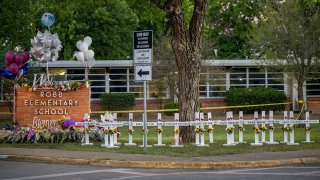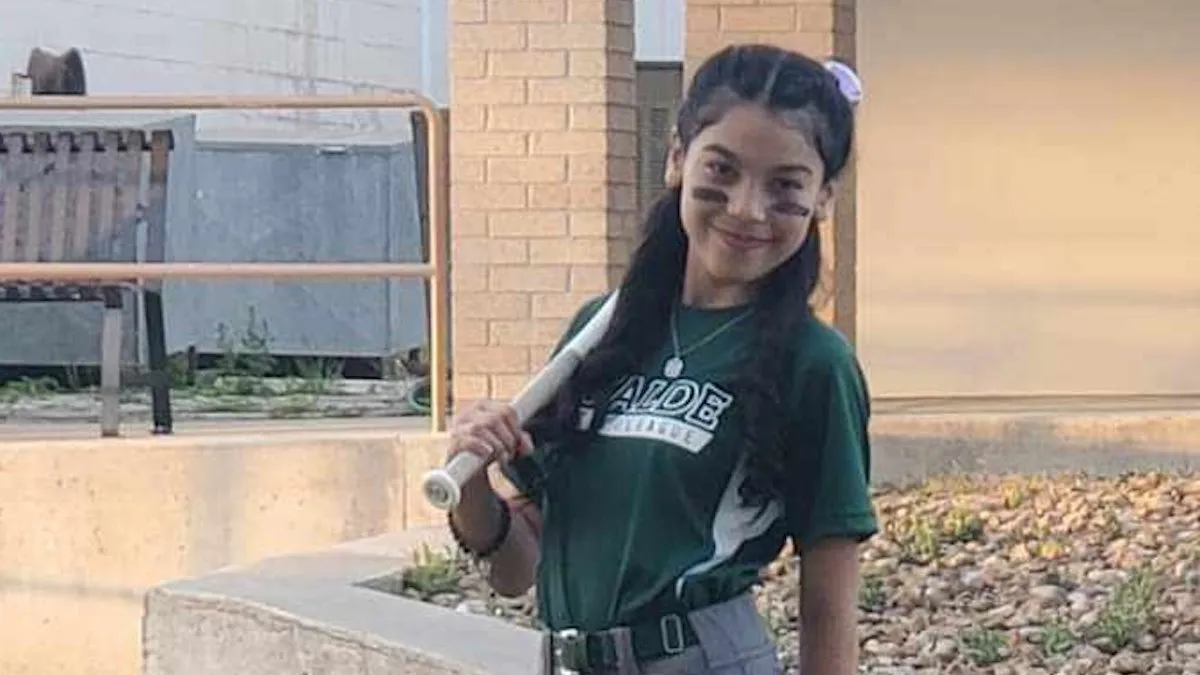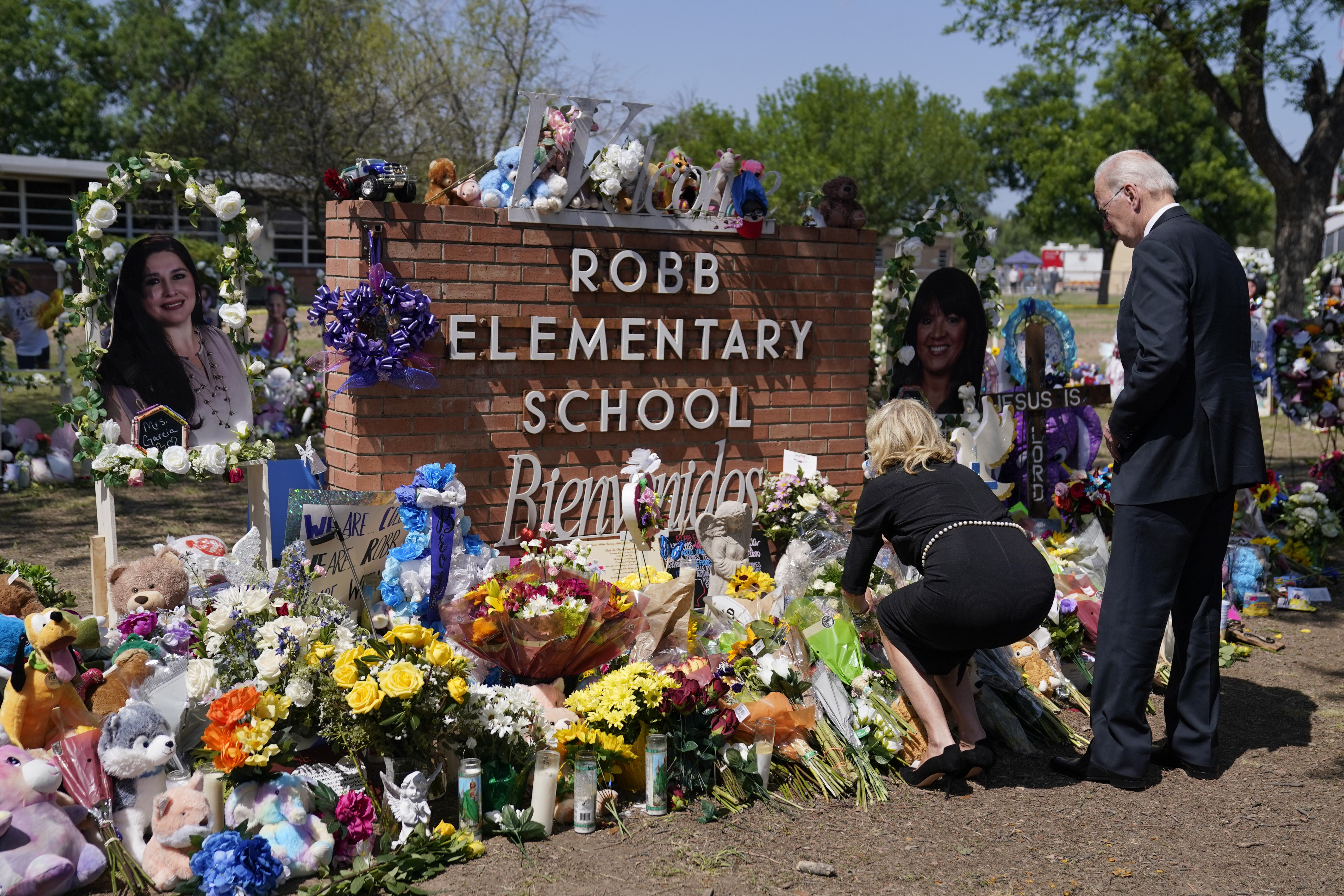
Warning: This story contains graphic information.
The only pediatrician serving Uvalde, Texas, is revealing what it was like to treat the wounded of the Robb Elementary School shooting, and sharing their horrific survivor stories.
Dr. Roy Guerrero, who was born and raised in Uvalde and attended Robb Elementary School as a child, was at lunch with his staff on Tuesday when he started getting frantic texts.
“I called the hospital, Uvalde Memorial, to ask if they needed me and they said, ‘Yes, get over here right now,'” said Guerrero, a board-certified pediatric specialist who practices in Uvalde and San Antonio.
Get top local stories in DFW delivered to you every morning. Sign up for NBC DFW's News Headlines newsletter.
Guerrero raced to the hospital.
"It was a complete madhouse — what you see in disaster movies," he added. "Doctors and nurses in every single room; people running around like maniacs; kids in the hallway bleeding and screaming; surgeons working on kids.
"The most horrible part, I guess, was just seeing parents I knew outside screaming, asking me to look for their kids. You never really get that out of your head."
Guerrero treated eight children personally that day — four of them are his regular patients.
He lost five of his patients in the shooting.
'I'm afraid he's coming for me'
As Guerrero made his rounds in the hospital the day of the shooting, treating the wounded and identifying the victims, he heard a familiar voice cry out to him.
“I heard, ‘Hey, Dr. G!” he said. Guerrero turned to find an 11-year-old girl he has treated since she was a newborn. He asked that TODAY not publish her name for privacy reasons.

The young girl was in the fourth grade classroom where 19 of her classmates and two of her teachers were shot and killed. She had bullet fragments in her shoulder.
She told her mom and the doctor what happened inside the classroom that day.
“She said she saw people being shot and falling dead. Her best friend was next to her, so she grabbed some of her blood that was coming out of her, smeared it on herself and played dead on the floor,” he said. “As she’s doing this, her teacher ... who got shot and was throwing up blood, told her, ‘I don’t want to die, call 911’ and threw the phone to her. I guess the guy saw the phone and shot the phone, but didn’t see her move. So she continued to play dead.”
Guerrero saw the 11-year-old the next day for a follow-up appointment.
“She was literally shaking,” he explained. “She already has PTSD, and we just got out of this.”
The child was not the only survivor Guerrero treated to show signs of post-traumatic stress disorder (PTSD) after the shooting, he says.
“In clinic the next day, all I heard was, ‘I’m afraid he’s coming for me. I’m afraid he’s going to come get me at my house.’ The kids were telling me that. I was hearing that the whole day,” he explained. “I’m telling you this is going to be a mental health crisis for our community.”
Guerrero worries that the child survivors will live in fear for the rest of their lives. It’s a fear, he imagines, that could even be passed down to their own children if something does not change.
“I don’t want them having that doubt in their mind, all the time, that the world is the same or worse, and that there’s nothing here to protect their children,” he explained. “That’s my biggest fear.”
Texas ranks last in the country for access to mental health services. In April, Texas Governor Gregg Abbott cut $211 million in mental health program funding.
'I told them I would be here until it was over'
Guerrero saidthe severity of the survivors' wounds varied. There were minor cuts and bruises on children who climbed out of busted-out windows to safety. Others had shrapnel injuries, including one little girl who had fragments of a bullet lodged in her shoulder.
"The children were in hysterics at first," he said. "But when they saw a familiar face — because I've known them for so long — I was able to calm them down. I told them I would be here until it was over and that I was going to call their mom."
Guerrero says those moments were as much a relief to him as it was a relief to the injured children.
"It was a blessing to see a familiar face that wasn't OK, but was alive," he explained. "And was going to stay alive. Because in the back of your mind, you knew there were many who weren't."
The doctor treats roughly 3,000 patients in the Uvalde area, and he says he feels protective about every single one of them.
"The second I start taking care of a kid, they're my kid," he added. "What people don't realize is that I have 3,000 babies — and that day, I lost some of them."
Waiting for the children who would never arrive
As the hours went on, it became apparent that some of the parents outside were not going to find their children alive.
Guerrero was instructed to be in the front of the receiving area to immediately help the other patients the hospital was expecting.
"We were supposed to have 14 more kids show up and they wanted me to triage them."
The 14 children never arrived.
"When you know, you know — I just knew," he said. "I tried to be positive and optimistic. But we knew what that meant."
Guerrero still had parents yelling at him, asking if their children were inside the hospital.
"So I asked the hospital to show me the bodies," he added. "I needed to make sure it wasn't who they were talking about."
The deceased children Guerrero viewed were not the kids of the parents in the waiting room of the hospital, but what he saw will never leave his mind.
"It was awful," he explained. "It was a high-power rifle injury. Almost decapitation, to that level. Open chest wounds. These are war wounds. It's as if things exploded once the bullets hit the bodies."
It wasn't until two days later that the trauma from the day caught up with him.
More Uvalde School Shooting Coverage
"I lost it for a little while," he said. "And that's OK, but I told myself to get it together. I have to take care of the rest of these kids. I can't lose myself."
Preparing to say goodbye, support survivors
As difficult as the day of the shooting and the hours that followed were, Guerrero says there is even more heartbreak ahead.
"The worst part is going to be next week when we have more vigils and funerals," he said. "It still feels surreal, and it will until we have the funerals next week and the week after that."
The first of many funerals will begin on Tuesday.
And while Guerrero is preparing to mourn the children he lost and the devastation that has occurred in his hometown, he is prepared to do whatever it takes to show up for his patients.
"There's an anger in everyone," he said. "Something is different this time. We seem to care about a shooting for two weeks, then sweep it under the rug. Not this time. The community has enough momentum and energy behind it that I think something is going to happen this time."
This story first appeared on TODAY.com. More from TODAY:



